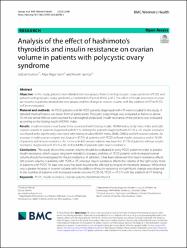| dc.contributor.author | Gencer, Gülcan | |
| dc.contributor.author | Serin, Aliye Nigar | |
| dc.contributor.author | Gencer, Kerem | |
| dc.date.accessioned | 2023-04-18T11:02:05Z | |
| dc.date.available | 2023-04-18T11:02:05Z | |
| dc.date.issued | 2023 | en_US |
| dc.identifier.citation | Gencer, G., Serin, A. N., & Gencer, K. (2023). Analysis of the effect of hashimoto's thyroiditis and insulin resistance on ovarian volume in patients with polycystic ovary syndrome. BMC Women's Health, 23(1), 1-7. | en_US |
| dc.identifier.issn | 1472-6874 | |
| dc.identifier.uri | https://dx.doi.org/10.1186/s12905-023-02200-x. | |
| dc.identifier.uri | https://hdl.handle.net/20.500.12933/1473 | |
| dc.description.abstract | Objective: In this study, patients were divided into two groups. Patients with polycystic ovary syndrome (PCOS) and patients with polycystic ovary syndrome + Hashimoto's Thyroid (PCOS + HT). The effect of insulin resistance on ovarian volume in patients divided into two groups and the change in ovarian volume with the addition of HT to PCOS will be investigated.
Material and methods: 46 PCOS patients and 46 PCOS patients diagnosed with HT were included in this study. A detailed medical history was taken from all participants. Polycystic ovary image was evaluated as below or above 10 ml and antral follicles were counted by transvaginal ultrasound. Insulin resistance of the patients was evaluated according to the fasting insulin (HOMA) index.
Results: Insulin resistance was found to be associated with fasting insulin, HOMA index, body mass index and right ovarian volume in patients diagnosed with PCOS. Among the patients diagnosed with PCOS + HT, insulin resistance was found to be significantly correlated with fasting insulin, HOMA index, (BMI), (SHBG) and left ovarian volume. An increase in right ovarian volume was found in 37.5% of patients with PCOS without insulin resistance and in 76.3% of patients with insulin resistance. An increase in left ovarian volume was found in 35.7% of patients without insulin resistance diagnosed with PCOS + HT and in 68.8% of patients with insulin resistance.
Conclusions: This study shows that ovarian volume should be evaluated in every PCOS patient in order to predict insulin resistance, which causes long-term metabolic diseases, and that all PCOS patients with increased ovarian volume should be investigated for insulin resistance. In addition, it has been observed that insulin resistance affects left ovarian volume in patients with PCOS + HT, whereas insulin resistance affects the volume of the right ovary more in patients with PCOS. At least one ovary has been found to be affected by long-term metabolic diseases. While there was a greater increase in ovarian volume with the addition of insulin resistance, no significant change was observed in the number of patients with increased ovarian volume (PCOS-58, PCOS + HT-57) with the addition of HT finding. | en_US |
| dc.language.iso | eng | en_US |
| dc.publisher | BioMed Central | en_US |
| dc.relation.isversionof | 10.1186/s12905-023-02200-x. | en_US |
| dc.rights | info:eu-repo/semantics/openAccess | en_US |
| dc.subject | Hashimoto Thyroid | en_US |
| dc.subject | Insulin Resistance | en_US |
| dc.subject | Ovarian Volume | en_US |
| dc.subject | PCOS | en_US |
| dc.title | Analysis of the effect of hashimoto's thyroiditis and insulin resistance on ovarian volume in patients with polycystic ovary syndrome | en_US |
| dc.type | article | en_US |
| dc.authorid | 0000-0002-3543-041X | en_US |
| dc.department | AFSÜ | en_US |
| dc.contributor.institutionauthor | Gencer, Gülcan | |
| dc.contributor.institutionauthor | Gencer, Kerem | |
| dc.identifier.volume | 23 | en_US |
| dc.identifier.issue | 1 | en_US |
| dc.relation.journal | BMC Women's Health | en_US |
| dc.relation.publicationcategory | Makale - Uluslararası Hakemli Dergi - Kurum Öğretim Elemanı | en_US |
















